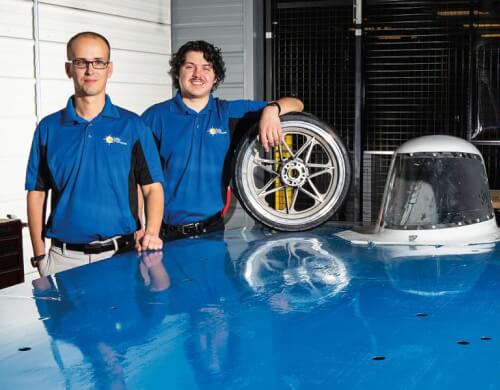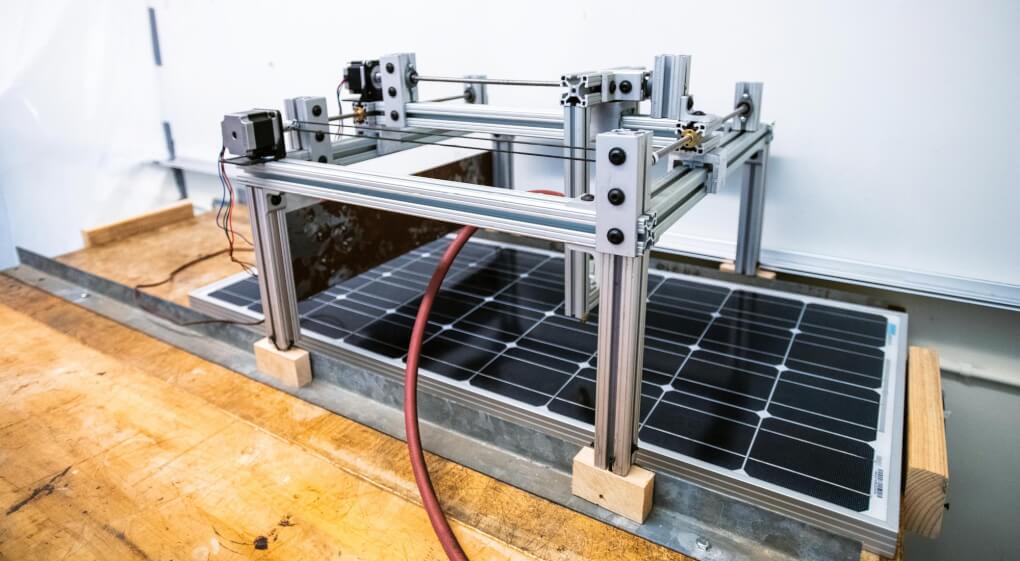When Grand Valley’s Solar Garden began operating on the Allendale Campus in April 2016, part of its purpose was to serve as an extension of the classroom.
The 17-acre, 11,200-solar-panel project provides electricity produced by solar energy to enrolled customers across the state, including the university.
Consumers Energy owns and operates the Solar Garden and provides grant monies for faculty-led interdisciplinary projects and curriculum. Below are highlights of research and projects currently underway.

Solar-powered race car project
Ryan Aldridge, operations manager at the Innovation Design Center, is the advisor for the GVSU Solar Racing Team student organization, which was founded in 2017. He received $3,000 to purchase batteries for the club’s solar-powered race car.
Club members are working on the design and construction of the race car. Students painted the 12-by-6-foot shell of the car Laker blue and are concentrating on assembling the inner workings.
Adam Duke, president of the GVSU Solar Racing Team, said the team hopes to compete in the 2020 Formula Sun Grand Prix in July.
“Working on the solar-powered car provides team members with an outlet where we can get hands-on experience to grow our skills and pursue our interests in renewable energy,” Duke said.

Self-cleaning solar panels
Heidi Jiao, professor of electrical engineering, and Chris Pung, associate professor of product design and manufacturing, received more than $4,800 to conduct research on coatings that can be applied to solar panels to protect them from environmental elements like wind, dirt and sand. Assisting them are senior engineering students Noe Villaneuva and Joe Ruemenapp.
The team is conducting indoor simulations and outdoor field tests on different types of solar panels, and testing the effectiveness of coatings to see how well each one repels dirt and water.
“Cleaning solar panels is labor intensive,” said Jiao. “Applying a thin layer of coating could make outdoor panels almost self-cleaning and manual cleaning wouldn’t be needed as often.”

Solar kiosk and electric mobile market
Youssef Darwich, farm manager and educator for the Sustainable Agriculture Project (SAP), received $2,290 to purchase an electric-powered bicycle and a solar-powered kiosk, which also serves as a charging station for the bike.
The kiosk, powered by solar panels on its roof, includes a welcome board and map to help visitors navigate SAP, the university’s education farm located just north of the Allendale Campus.
Darwich said the electric-powered bike is used to transport the SAP Mobile Market to campus.
“It’s one mile from the garden to campus and using the electric bike has drastically improved our ability to transport our trailer filled with vegetables, flowers, honey and much more,” Youssef said.
The bicycle can travel 25 miles fully changed, so Darwich said Mobile Market locations could expand to include the Pew Grand Rapids Campus, in addition to current high-traffic locations on the Allendale Campus near Kirkhof Center and bus stops.

K-12 outreach kits
Sara Maas, outreach coordinator in the Padnos College of Engineering and Computing, received $3,400 to develop educational kits to be used by K-12 students during field trips to the Innovation Design Center.
The kits for younger students include solar bugs that introduce them to solar cells, circuits and motors. Maas said in ideal conditions, the solar bugs hop around on pipe cleaner legs, thanks to a tiny motor with an offset weight.
Upper elementary and middle school students use kits with solar mechanical toys similar to K’nex sets, which have interchangeable pieces to create multiple designs. “The most complex build designs are solar cars and solar motorcycles,” Maas said. “We look forward to hosting a field trip where the students can build a design and then we can have a race.”
The kits geared for high school students include solar arrays, LEDs, diodes, resistors, switches, battery packs and a digital multimeter (DMM). Students have the opportunity to wire circuits and take measurements with the DMM.








